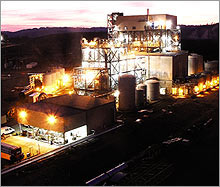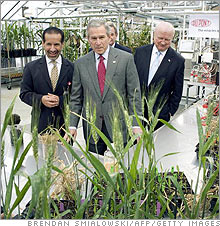Chemical reactionFrom gunpowder to polymers, DuPont has survived by adapting. Now the company is in the midst of its most audacious transformation. The goal: to improve the environment and make a fortune doing it.(Fortune Magazine) -- Not so long ago the scene inside Room 406 of the U.S. Senate's Dirksen building would have been inconceivable. There, on a mid-February morning, sat top executives of three old-economy behemoths - DuPont, the 205-year-old science company; BP, the oil giant; and PG&E, California's largest utility. The corporate chieftains weren't there to fend off regulation, but to request it. "Prompt action by Congress is needed" on climate change, DuPont CEO Chad Holliday told the Senate Committee on Environment and Public Works. DuPont (Charts) is part of a new group called the U.S. Climate Action Partnership (USCAP), which has proposed a plan that would force companies to reduce their greenhouse-gas emissions and also implement a market mechanism that would lower the costs of doing so.
USCAP counts GE (Charts), Alcoa (Charts), Caterpillar (Charts), and several power companies as members, as well as groups like the Natural Resources Defense Council and the World Resources Institute, whose president was sitting shoulder to shoulder with Holliday. Some of the Senators seemed dazzled by the union of gray and green. "You've got our attention," said Virginia Republican John Warner. Faster than you can say "cellulosic ethanol," the idea of greening business has gone from eccentric to mainstream. But DuPont has been at it much longer than most. Since 1990 the company has been working its way through the two stages of sustainability: first, drastically reducing how much it pollutes (an effort that continues), and second, embracing sustainability as a strategic goal. DuPont's journey makes it a good test case to examine the opportunities - and challenges - for big industrial companies that want to make environmentalism both an operational imperative and a core principle. By DuPont's definition, $5 billion of its $29 billion in revenue comes from sustainable products. These can be pure-green materials, such as bio-PDO, a corn-based substance that can be turned into a fiber for suits or carpets or even made into deicing solutions for airplanes. Or they can be products such as Tyvek - a chemically based material that dates to the 1950s - that can be used in new ways to improve energy efficiency. What remains unclear is whether this effort will pay off - for DuPont or for any other company that declares its devotion to the planet. "People don't pay for green for green's sake," says Deutsche Bank analyst David Begleiter. "They pay for black, which is earnings. Green is not the new black. Black is still black." Chad Holliday wouldn't disagree; he likes black too. He has very practical reasons for requesting legislation on greenhouse gases. For starters, he thinks climate-change rules are inevitable, and he'd like to help shape them, in particular to make sure that DuPont gets credit for the massive voluntary emission cuts it has already made - 72 percent since 1990 (with plans for another 15 percent by 2015). No doubt he also wouldn't mind if his competitors faced the same restrictions DuPont has imposed on itself. More important, Holliday, like GE's Jeff Immelt, who is taking a similar tack, believes his company could make a lot of money in a carbon-constrained world on everything from alternative fuels to materials that save energy. Holliday, 59, is a DuPont lifer. An industrial engineer by training, he landed a summer job at the company while attending the University of Tennessee, in his home state, then signed on full-time after graduation in 1970. Relaxed and chatty, he is quick with self-deprecating comments ("I've never had an original idea - it's always somebody else's idea, okay?"). He has been known to show up for interviews in one of the two suits he had made for himself out of DuPont's corn-based bio-PDO. (For Fortune, he opts for a traditional fiber, in pinstripes.) Despite his genial demeanor, Holliday is well aware that his company's stock stands about 10 percent below its price when he took over in February 1998. (The Dow rose roughly 17 percent during the same period.) A big reason for the feeble showing has been the struggle to reinvent DuPont. Yes, that $5 billion in revenue from sustainable products is impressive, but it's taken an awful lot of pain - plus the occasional zigzag - to get there. DuPont's overhaul has required $60 billion in deals. The company sold its Conoco oil unit in 1999 for $11.7 billion - and thus missed out on one of the largest oil booms in history. It used $7.7 billion of the proceeds to acquire the 80 percent of seed maker Pioneer Hi-Bred it didn't own. But it overpaid, and had to write off $2.9 billion in goodwill on the deal a couple of years later. And after years of fretting, in 2004 DuPont sold off its Invista unit, which manufactures materials such as nylon, a core product for more than half a century. By agonizing over the move, DuPont probably missed getting the best price, selling on the wrong end of the commoditization curve. Finally - and this decision seems hard to criticize - it bailed out of a brief foray into the pharmaceutical business. When all the buying and selling was over, in 2004, what remained was no longer a $40 billion chemical and polymer titan but a $29 billion enterprise that now uses way more chemicals than it produces - and derives a large chunk of its revenues from fertilizers and seeds for corn and soy, while continuing to make well-known DuPont brand names such as Kevlar, Corian, Tyvek and Teflon. The transformation was not DuPont's first; 75 years ago it abandoned the explosives business and reincarnated itself as the haute science inventor of polymer chemistry that would shape our lives with the likes of nylon, Lucite, and Dacron. "That transition took decades of fundamental research," says Paul Tebo, who retired as DuPont's top sustainability executive in 2004. "And what you are seeing now is the same type of transition." |
Sponsors
| ||||||||||||||||||||



